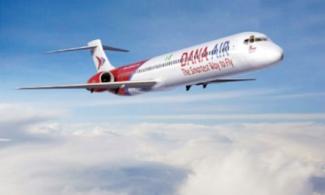
A preliminary independent inquiry into the Dana Air crash of Sunday June 3, 2012 reveals that Dana Air might have purchased an aircraft with a pre-existing safety issue and a troubling past safety record. The question therefore is whether the necessary due diligence was carried out on the aircraft in question prior to purchase and operation in Nigeria. Or whether the Nigerian aviation authorities were aware of this fact before allowing the said aircraft into service locally.
A preliminary independent inquiry into the Dana Air crash of Sunday June 3, 2012 reveals that Dana Air might have purchased an aircraft with a pre-existing safety issue and a troubling past safety record. The question therefore is whether the necessary due diligence was carried out on the aircraft in question prior to purchase and operation in Nigeria. Or whether the Nigerian aviation authorities were aware of this fact before allowing the said aircraft into service locally.
googletag.cmd.push(function() { googletag.display('content1'); });
Dana Air’s McDonnell Douglas - MD-83 - jet is part of a fleet that was sold off by Alaskan Airlines in 2008 as the company upgraded its existing fleet to include more fuel-efficient aircrafts.
However, prior to this deal Alaskan Airlines has had several incidents with some of its MD-83 aircrafts, at least one of such incidents resulted in a fatal air crash. The air crash occurred on January 31st 2000, when Alaskan Airlines 261, crashed into the Pacific Ocean killing two pilots, three cabin crewmembers, and 83 passengers.
The crash occurred following the loss of the horizontal stabilizer control. Inadequate maintenance was cited by the United States’ Federal Aviation Administration (FAA) as the primary cause of the crash, which had originated from a worn out acme nut and jackscrew within the aircraft’s assembly.
With regards to the specific Dana aircraft in question, which flew within the Nigerian airspace under registration number 5N-RAM, it was discovered that this aircraft was previously registered to Alaskan Airlines with FAA N-number N944AS. The Construction Number (CN) of the plane was 53019/1783.
Checks with the United States National Transportation Safety Board (NTSB) revealed that the ill-fated aircraft, which first flew in 1990, had a previous aircraft incident within US airspace. The incident occurred on the August 20th 2006 and is listed in NTSB records as incident LAX06IA301. On that day, the plane landed without incident, but while taxiing to parking, the cabin crew intimated their colleagues on the flight crew about an smelly smoke from an electrical spark , which had permeated the cabin area.
Around the same time circuit breakers popped and alarms went off. The plane was stopped, and an emergency evacuation of all passengers on board took place. A direct quote from the NTSB report states that: “Maintenance personnel noted minor damage to the airplane as a result of a chaffed wire bundle in the mid-cargo pit ceiling at station 750 that had arced and produced smoke in the cabin area. The area was identified as a Boeing-designed and retrofitted over wing heater wiring installation."
“Engineers for the operator and manufacturer of the airplane determined that arcing was likely due to the left and right over wing heater blanket wiring that contacted the edge of the wire bundle bracket that attached to the second inboard lighting hole at station 750 in the mid-cargo pit ceiling on the left side."
They also determined that the vibration through normal airplane operation allowed the bracket to cut through the wire insulation and then contact was made to the wire conductor and arcing occurred. The operator inspected their entire fleet of affected airplanes and noted one other wire bundle discrepancy.
“The Manufacturer of the airplane identified one other operator with a similar configuration. A service bulletin was issued identifying the problem and provided instructions on adjusting the cable bundles in order to prevent future occurrences”.
Although the actual cause of Sunday’s air crash is yet to be determined, the question remains as to whether the problems of this aircraft were resolved satisfactorily and whether the eventual buyers of the plane (Dana Air) and the Nigerian Ministry of Aviation were aware of this fact and took necessary measures to ensure that the aircraft was safe enough to operate within Nigeria’s airspace.
While we wait for an official explanation, following the promised"a thorough investigation” from aviation authorities, we will take the necessary steps to conduct a more comprehensive independent investigation in the short-term lest this become another victim of a quickly forgotten tragedy. Copies of a final report will be made available to the necessary authorities and the general public. We believe that this aircraft accident calls to question the information made available to the Nigerian flying public about the aircraft in service with various aviation operators in the country and the maintenance/operational standards of these operators. Fidel Agbobu
googletag.cmd.push(function() { googletag.display('comments'); });
googletag.cmd.push(function() { googletag.display('content2'); });